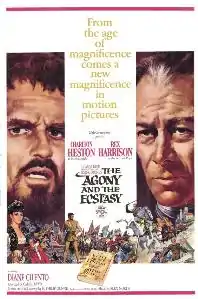| The Agony and the Ecstasy | |
|---|---|
 Theatrical release poster by Howard Terpning | |
| Directed by | Carol Reed |
| Screenplay by | Philip Dunne |
| Based on | The Agony and the Ecstasy 1961 novel by Irving Stone |
| Produced by | Carol Reed |
| Starring | Charlton Heston Rex Harrison Diane Cilento Harry Andrews Alberto Lupo |
| Cinematography | Leon Shamroy |
| Edited by | Samuel E. Beetley |
| Music by | Jerry Goldsmith Alex North |
Production company | International Classics |
| Distributed by | 20th Century Fox |
Release date |
|
Running time | 138 minutes |
| Country | United States |
| Language | English |
| Budget | $7 million[1] |
| Box office | $8 million[2] |
The Agony and the Ecstasy is a 1965 American historical drama film directed by Carol Reed and starring Charlton Heston as Michelangelo and Rex Harrison as Pope Julius II. The film was partly based on Irving Stone's 1961 biographical novel of the same name, and deals with the conflicts of Michelangelo and Pope Julius II during the 1508-1512 painting of the Sistine Chapel ceiling. It also features a soundtrack by prolific composers Alex North and Jerry Goldsmith.[3]
The film was shot in Todd-AO and Cinemascope versions. The Todd-AO version was used for the DVD release because of its superior picture quality.
Plot
The film opens in documentary style, chronicling the work of Michelangelo Buonarroti. It then follows Michelangelo, a renowned sculptor of the Republic of Florence in the early 16th century, and shows him at work on large-scale sculptures near St. Peter's Basilica. When Pope Julius II commissions him to paint the Sistine Chapel, Michelangelo resists because he finds the ceiling's paneled layout of the Twelve Apostles uninspiring. Nonetheless, he is forced into taking the job. During the initial attempt, Michelangelo is discontented with the results, and destroys the frescoes. He flees to Carrara, and then into the mountains where he finds inspiration from nature.
Michelangelo returns and is allowed to paint the entire vault in a variety of newly designed biblical scenes. The work proceeds nonstop, even with Mass in session, as months turn to years. Michelangelo's work is threatened when he collapses due to fatigue. He is nursed back to health by Contessina de' Medici, daughter of his old friend Lorenzo de' Medici. After recovering, Michelangelo returns to work after learning he is at risk of being replaced by Raphael.
Meanwhile, the Papal States are threatened during the War of the League of Cambrai. Preparing for battle and having reached the limits of his patience, the Pope terminates Michelangelo's contract. Raphael, impressed with the work in progress, asks Michelangelo to show humility and finish the ceiling. Michelangelo travels to see the injured and weakened Pope, and pleads for him to restore the patronage. Though the Pope believes an invasion of Rome is inevitable, he raises the money needed to resume work on the ceiling.
One night, Michelangelo finds the ailing Pope inspecting the portrait of God in The Creation of Adam, which the Pope declares "a proof of faith." He then collapses and becomes bedridden. Though everyone assumes that the Pope will die, Michelangelo goads him into having the will to live and to finish his work. The tide of war turns in favor of the Papal States, as allies pledge to assist the Pope.
A Mass is held in which the congregation is shown the completed ceiling. After the ceremony, Michelangelo asks to begin carving the Pope's tomb. Realizing he has a short time to live, the Pope agrees. Together, the men admire the masterpiece of the Sistine Chapel, until Pope Julius walks away and Michelangelo turns to look at the space behind the altar where he would later paint his Last Judgement.
Cast
- Charlton Heston – Michelangelo Buonarroti
- Rex Harrison – Pope Julius II
- Diane Cilento – Contessina Antonia Romola de' Medici
- Harry Andrews – Donato Bramante
- Alberto Lupo – Duke of Urbino
- Adolfo Celi – Giovanni de' Medici
- Venantino Venantini – Paris De Grassis
- John Stacy – Giuliano da Sangallo
- Fausto Tozzi – Foreman
- Maxine Audley – Woman
- Tomas Milian – Raphael
Production
Film rights to the novel were bought by 20th Century Fox for a reported $125,000. The head of the studio was Peter Levathes, and Burt Lancaster was linked to the film.[4] In 1962, Fox almost collapsed due to cost over-runs on a number of films, notably Cleopatra. This resulted in Darryl F. Zanuck returning to run the studio. He installed his son Richard D. Zanuck as head of production.[5]
In January 1963, Richard Zanuck signed Philip Dunne to write the script.[6] In October 1963, Zanuck announced the film would be one of six "roadshow" movies the company would make over the next 12 months, worth $42 million all up. The others would be The Day Custer Fell (turned into Custer of the West), Those Magnificent Men in Their Flying Machines, Justine, The Sound of Music and The Sand Pebbles.[7] In November 1963, Charlton Heston signed to play the lead.[8] Fox wanted Rex Harrison to co star and he wanted Fred Zinnemann to direct.[9] By January, Carol Reed was set to direct and Rex Harrison to co star.[10]
Shooting
The film's production schedule ran from June 1964 to September 1964. When it came time to film the feature, the Sistine Chapel could not be used, and it was recreated on a sound stage at Cinecittà Studios in Rome. During the production, Rex Harrison and Charlton Heston did not get along. (Reed and Heston had originally wanted Laurence Olivier for Pope Julius, but he was unavailable.) Twelve years later, while filming The Prince and the Pauper, Harrison completely avoided Heston.
According to his diary, Heston was interested in playing Michelangelo before any studios decided to produce the film. Once cast in the part, he was excited to act under Reed, who had directed The Third Man (1949). Heston felt that this would be the film to resurrect Reed's directorial reputation, describing it as having the best audience-preview responses of any film he had ever seen. However, it only did modest business at the box office.[11]
Release
Box office
The film grossed around $4,000,000 during its US theatrical run in 1965. It later went on to make about $8,166,000 worldwide in rentals.[12] In September 1970 Fox estimated the film had lost the studio $5,281,000.[13]
Critical reception
On the review aggregator website Rotten Tomatoes, 86% of 7 critics' reviews are positive, with an average rating of 6.6/10.[14]
Bosley Crowther of The New York Times felt the film was, "not a strong and soaring drama but an illustrated lecture on a slow artist at work." He sympathized with the Pope and his mounting impatience with Michelangelo, criticizing Heston's acting as lacking any warmth to endear him to the audience. Furthermore, he believed the script suffered from being "wordy."[15]
In a 2013 retrospective review in The Guardian, Alex von Tunzelmann noted that the film's "intent to inform is laudable, but a fictional film should really be able to convey its subject without a lecture," and echoed Crowther's observation that "the screenplay goes heavy on the dialogue, light on the action." She laments that the sex-less film fails to reveal "the real Michelangelo's passions" (particularly his reputed attraction to men), and concluded the film would have been more interesting "if it were told with a lot more humour and a lot less prudishness."[16]
Accolades
The film was nominated for five Academy Awards:[17][18]
- Best Art Direction, color (John DeCuir, Jack Martin Smith, and Dario Simoni)
- Best Cinematography, color (Leon Shamroy)
- Best Costume Design, color (Vittorio Nino Novarese)
- Best Original Score (Alex North)
- Best Sound (James Corcoran)
It was nominated for two Golden Globe Awards:
- Best Actor (Rex Harrison)
- Best Screenplay (Philip Dunne)
It won two awards from the National Board of Review:
- Best Supporting Actor (Harry Andrews)
- One of the Year's 10 Best
It won the Best Foreign Film at the David di Donatello Awards.
See also
References
- ↑ Solomon, Aubrey (2002). Twentieth Century Fox: A Corporate and Financial History. Rowman & Littlefield. p. 254. ISBN 978-0-8108-4244-1.
- ↑ "The Agony and the Ecstasy, Box Office Information". The Numbers. Retrieved January 22, 2013.
- ↑ Clemmensen, Christian. "Jerry Goldsmith (1929-2004) tribute". Filmtracks.com. Retrieved 2011-04-14.
- ↑ Archer, Eugene (January 14, 1962). "BY WAY OF REPORT: Top Novel and Hit Play Acquired for Movies". The New York Times. p. X9.
- ↑ Schumach, Murray (February 14, 1963). "FOX STUDIO BACK IN PRODUCTION". The New York Times. p. 5. Retrieved December 31, 2022.
- ↑ "Dunne Will Script 'Agony and Ecstasy'". Los Angeles Times. January 14, 1963. p. C12. Retrieved December 31, 2022.
- ↑ "20th Century-Fox to Spend $42 Million on Six Movies". Los Angeles Times. October 10, 1963. p. A1. Retrieved December 31, 2022.
- ↑ "New role for Heston". The Christian Science Monitor. November 11, 1963: 6.
- ↑ Hopper, Hedda (December 6, 1963). "Looking at Hollywood: Harrison to Get Choice of Film Scripts". Chicago Tribune. p. B14.
- ↑ Scheuer, Philip K. (January 16, 1964). "Carol Reed Directs Heston, Harrison: Buchwald 'Claim Check' Set; Scofield as Train Passenger". Los Angeles Times. p. C9.
- ↑ Ben Mankiewicz on Turner Classic Movies
- ↑ "The Agony and the Ecstasy". IMDb. 7 October 1965.
- ↑ Silverman, Stephen M. (1988). The Fox that got away: the last days of the Zanuck dynasty at Twentieth Century-Fox. L. Stuart. p. 259. ISBN 978-0-8184-0485-6.
- ↑ "The Agony and the Ecstasy". Rotten Tomatoes. Fandango Media. Retrieved October 7, 2021.
- ↑ Crowther, Bosley (October 9, 1965). "Michelangelo Firm Opens in N.Y.". The New York Times. Retrieved December 31, 2022.
- ↑ "The Agony and the Ecstasy: more passion would've been less painful". The Guardian. London. May 24, 2013. Retrieved June 30, 2016.
- ↑ "The 38th Academy Awards (1966) Nominees and Winners". AMPAS. Retrieved 2011-08-24.
- ↑ "The Agony and the Ecstasy". Movies & TV Dept. The New York Times. February 13, 2009. Archived from the original on 2009-02-13. Retrieved 2008-12-26.
